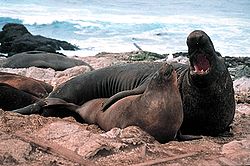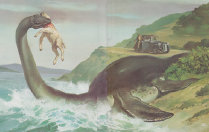
Contact

Home
Loch Ness Monster part 10

1934

continued
LOCH NESS "MONSTER "
IS IT A TIN FISH?
Radio Expert on Amazing Theory.
Sunday Times (Perth, WA)
Date: March 4, 1934
Page Number: 11 S
According to Leonard O. Mosley, in the "Empire News," (England), statements made to him at Edinburgh exclusively by two great authorities, suggest that the "monster" is not some strange new denison of the deep at all, but a brilliantly ingenious new mechanical contrivance being tested in these wild waters for purposes of
secrecy.
All the evidence of witnesses of the Loch phenomenon, when combined with that of the experts referred to, points to the presence in the Loch of a specially-equipped type of torpedo, which is being manoeuvred about the Loch by means of a remote radio control.
It will be recalled that some such experimentation was being carried on elsewhere in the summer when control stations aboard ships and on shore guided torpedoes to set destinations.
Mr. A. H. Baird, a leading Scottish radio authority, pointed out to Mosley that an aeroplane flown from Hull, by Griegson, only a few months ago, was piloted by radio as far as Greenland!
"It is quite feasible for a torpedo to have been placed in Loch Ness," said Mr. Baird, "and guided about the loch with the same results as in the open sea.
"For one thing the waters are so deep that they have not yet been plumbed, and, therefore, rock formations at the bottom would not interfere with wireless reception.
"You have to remember that the phenomenon has been seen mostly at the western end of the loch, well away from the populated districts around Inverness.
"The main road is on the north side, and while the south side is not exactly unpopulated, it is quite off the beaten track.
"If the monster is, In fact, a torpedo, the remote controlling station guiding it would have to be somewhere along the southern bank, unless a more powerful station at a great distance is being utilised.
"You have to remember, of course, that wireless rays—at least as far as we know—cannot penetrate water, and the torpedo could only be guided along the surface.
"But it is quite possible that there is inside the torpedo some device which can flood part of the chambers, thus sending the torpedo below.
"After a certain time has elapsed an air-pressure mechanism would go to work, blow out all the water, and bring the torpedo to the surface again, when the wireless station would once more take control.
"This would give the impression, as witnesses have described, of the undulating motion of some strange monster.
"Wireless could not, of course, control anything moving along the ground, and by this time three people claim to have seen the monster on dry land.
"The only possible explanation of that is that people's eyes are notoriously unreliable, and what they took for an unknown amphibian walking across the road might, I admit, have been men carrying away a torpedo."
Giving it some thought, it must be admitted that men carrying the torpedo between them, their steps surreptitious, their heads and shoulders bent, might, from a distance, convince witnesses that what they saw was a long, snake-like animal with short legs, and two humps upon its back.
Otherwise, what is the explanption? Until a few days ago witnesses described the monster as being 30 feet
long.
Now they swear it is ten feet long, and a torpedo is 12 feet!
ITS SPEED.
Reference has been made to its phenomenal speed. Mr. T. H. Gillespie, director of the Scottish Zoological Gardens, says the only things he knows which could move at such a speed are sea lions or seals, which can touch 40 miles an hour when chasing fish.
"They speed along just like a torpedo," Mr. Gillespie said, very significantly, for there had been no mention of anything about a radio-controlled mechanism.
"But they cannot keep up the pace for long.
"It is highly unlikely to be a sea lion, for they do not come into these waters, and I doubt the theory that it is a sea elephant because it is questionable whether the food is suitable or the water warm enough."
One suggestion is that the hunters should try, with music, to entice the "monster" to show itself, but it ls doubtful whether the bagpipes would act like a charm, even at hogmanay!
The Inverness correspondent of "The Sunday Times" (London) says that the people living on the shores of Loch Ness are in no fear of the monster or monsters that are rumored to infest the deep waters. Their fears are concerned with the effect the sudden publicity may have on the all-important salmon-fishing season, which opened on January 15.
He motored the thirty or more miles round the loch, and saw nothing of the "monster," but heard that Inverness hotel and shopkeepers are at least £1000 in pocket through the extra visitors the fact or fable has attracted. But the hotelkeepers, boatmen and ghillies on the shores of the loch, who depend on salmon and trout anglers for a livelihood, view the matter from a very different standpoint.
One hotelkeeper said: "The stories of the monster affected last season. The majority of our angling guests simply hugged the shore, and so far as I know none of them ventured to cross the loch. We are afraid that many of them may not visit us at all this season."


Leonard Mosley (11 February 1913 – June 1992) was a British journalist, historian, biographer and novelist.

Thomas Haining Gillespie[1] (3 October 1876 – 3 August 1967) was a Scottish solicitor, zoological administrator, and broadcaster.




LOCH NESS MONSTER
Conflicting Theories
Morning Bulletin (Rockhampton, Qld.)
Date: March 8, 1934
Page Number: 11

From the earliest times the Scottish Highlands have been a region of mystery and legend, an effect ascribed to the somewhat mystical and highly poetical mentality of the inhabitants. They saw—and it is rumoured, still see —things not visible to ordinary mortal eyes; "second sight" was a recognised and fairly frequent phenomenon, and the woods and hills around them were the haunt of fairies and elves.
In recent years, however, the Highlands have been "opened up," railways run along the glens and great highways cross the mountains. Prosaic Anglo-Saxon eyes have viewed these hills and lochs, these glens and moors, and have seen their beauty, but no more. Highlanders still have their songs and their poetry, but their country is no longer unknown land, and, becoming known, has emerged from the mists of legend and fairy-tale. Or so it was thought until the autumn of 1933.
About that time paragraphs began to appear about something strange in Loch Ness. Local inhabitants had seen something large and alive in the water, where normally nothing bigger than a salmon lives and moves. lt was seen again, and again.
The newspaper paragraphs grew longer and the headlines bigger. Papers of other countries took up the tale, and soon the whole world was reading of "the Loch Ness Monster."
Reporters and photographers began to haunt the shores of the loch, and learned professors gave their opinions as to what this strange visitor might be.
Meanwhile, its lusty splashings continued to disturb the tranquil waters of Loch Ness until quite a large number of people had been vouchsafed a glimpse of it, without, however, making it possible to offer any explanation of what it was or how it got there.
That is the position to-day. Few now doubt that there is something in Loch Ness, but the theories as to what it is are numerous and contradictory. There is the giant eel school of thought, closely allied to the giant newt theory. Others say it is only a seal, or even a walrus. Believers in the sea-serpent are happily saying "I told you so!" but perhaps the most pleasing theory of all is that this is some reptilian survivor from pre-historic times has lived in the depths of Loch Ness for thousands of years, and has only now come to the surface disturbed by blasting operations in connection with the reconstruction of the road along the lochs.
KELPIE STORIES JUSTIFIED?
Now many of the ancient Highland legends have to do with kelpies, strange water-beasts, the presence of which struck terror into whole neighbourhoods. Tales of them have usually been ascribed to the vivid imagination of uneducated people living in wild and lonely, sometimes eerie surroundings. But here we have something happening in Loch Ness in 1933, and in 1934, too, and the people who have seen the "monster" are educated people, in regular contact with the outside world. May not the old kelpie stories spring from a similar cause, and were the Highlanders of old as superstitious as the world has been led to believe?
In any ease, this summer, when the holiday season comes round, it is certain that many thousands will flock to the Loch Ness district, and even if they see no "monster" they will not come in vain. Loch Ness, with or without monsters, is worth coming a long way to see.
Second sight is a form of extrasensory perception, the supposed power to perceive things that are not present to the senses, whereby
a person perceives information, in the form of a vision, about future events before they happen (precognition), or about things or
events at remote locations (remote viewing). Second sight may have originally been so called because normal vision was regarded as
coming first, while supernormal vision is a secondary thing, confined to certain individuals.

THE LOCH NESS MONSTE
Evidence Analysed.
The Queenslander (Brisbane, Qld.)
Date: March 8, 1934
Page Number: 12

NO zoologist would deny the possibility of discovering a large creature, of "prehistoric type" (whatever that may mean), hitherto unknown to Science, in vast ocean solitudes, in imperfectly explored foreign lands, or even in the limited and completely surveyed waters of Lock Ness. But for more than 200 years zoologists have been busy ransacking the world, and the chance of finding a large vertebrate animal of a type entirely new to Science living anywhere, either on the land or in the sea, grows smaller and smaller every day (writes Martin A. C. Hinton, deputy keeper of zoology, British Museum of Natural History, in the course of an interesting article in "The Field"). The larger animals of the North Atlantic and the North Sea are fairly well known, and the chance of making a sensational addition to the list is now small indeed. To establish such a discovery to-day the zoologist would be required to furnish rigid proof based upon a personal examination of at least some characteristic portion of the alleged new animal. . . .
We may accept the 51 eye-witnesses interrogated by Commander Gould and the score or more later witnesses who have made statements describing what they have seen of the Loch Ness "monster" as witnesses of truth; that is to say, each of them has done his best to describe, without addition, subtraction, or embellishment, what he thinks he saw on the loch or on its shores. Accurate observation even of familiar stationary things on land, is a very difficult art; and accurate description of the impression left by the observation is still more difficult. These difficulties are enormously enhanced when the observation concerns an unfamiliar object seen at some considerable distance in motion in the water, where light, reflections, ripple, wind, and haze change from second to second.
Considerations such as these would lead us to expect many discrepancies of detail in the stories of the witnesses; so that no adverse criticism could be based upon the variable nature of their accounts. The more honest and uninstructed the witnesses the more they will differ from each other and the more difficult it will be for the zoologist to find out what it is they are all endeavouring to describe. One fact alone does emerge from this great mass of testimony, namely, that for some months the loch has been inhabited by one or more large animals not usually there.
Accepting the statements of two or three of the witnesses, we find that the intruder is not confined to the water but comes on shore from time to time, crossing the road, and ascending the slope beyond. One observer surprised the creature on the roadside at night nearly 40yds. ahead. "As he approached, the creature moved, turned a small head in his direction, and then with great bounds crossed the road and plunged into the water." Further, "it had . . . large oval-shaped eyes set almost on top of its head . . . a big heavy body, and there were two flippers in front. It seemed also . . . to have two legs behind, and they appeared to be webbed." From other witnesses we learn that the "monster" chases the salmon, and that it is most frequently seen round the mouths of the streams flowing into the loch or near the exits of the Ness by which the salmon enter from the sea. Several mauled salmon have been found, in- cluding at least one "kelt," important as showing that the injuries were sustained in the loch and not on the upward run of the fish.
A Grey Seal.
NOW all these facts, looked at broadly, are in harmony with the view that the loch has been invaded by one or more grey seals. They are common in the Dornoch Firth and by no means infrequent in the Beauly Firth. They prey upon the salmon, and probably one or more followed the salmon up the River Ness last year. Seals have been seen in the loch on previous occasions. The river presents almost insurmountable obstacles to any large marine vertebrate other than a seal or a salmon; but to the grey seal, capable as we know of doing a journey of 30 miles over rough country, the ascent would be easy. The general description of the individual seen on land and of its progress across the road into the water, quoted above, fits the grey seal to perfection if we make allowance for an excusable overestimate of size.
Great attempts have been made to lead zoologists to a more romantic conclusion. Much stress has been laid upon the supposed colossal length of the "monster," its small head, long out-stretched neck, and serpentine body indicated by humps visible above the water. Each description of the swimming animal is a simple summary of the impressions made upon the mind of each observer by a longer or shorter series of continually changing images. In no one of them could we put implicit trust. . . .
The "Daily Mail" with customary enterprise, sent investigators. These included a big-game hunter, who eventually found two impressions of a large foot upon the shore. Photographs and a cast of these were submitted to the museum, where the impressions were found to have been made on a heaped-up bank of fine shingle with the help of a stuffed foot of a hippopotamus. A wag had been busy—had he used a living hippopotamus the impression would have been different and the big game hunter would not have been deceived. On the other side of the loch the animal which bounded across the road, described above, left a trail. In that trail was an obscure footprint of which a cast was also made. At the museum it was found that this footprint was also the work of a joker—but this time used the mounted foot of a rhinoceros.
Efforts were made to "film" the "monster." Some of the first pictures were reproduced in various newspapers, and two slides made from one of them were shown to the meeting of British zoologists on January 6. They showed nothing that could be positively identified as an animal.
Although apparently not of great scientific interest, the "monster" is of considerable importance to local industries and to the great world of advertisement. In gratitude business men are asked to address it privately as "ministering angel," reserving "monster" for public occasions.

Martin Alister Campbell Hinton (29 June 1883 – 3 October 1961) was a British zoologist.
Hinton is among those associated with
the Piltdown Man hoax, a composite of an altered human skull and ape jawbone planted, and subsequently 'discovered', at a dig in Piltdown,
England, and presented as a missing link between man and ape. A trunk belonging to Hinton left in storage at the Natural History Museum
and found in 1970 contained animal bones and teeth carved and stained in a manner similar to the Piltdown finds, and raising questions
about Hinton's involvement in the deception.



LOCH NESS MYSTERY
SUPPOSED GREY SEAL
Theory Regarding "Monster"
The Canberra Times (ACT)
Date: March 9, 1934
Page Number: 2

According to the special mission sent to Loch Ness by the Daily Mail to clear up the "monster" mystery, evidence more and more points to the fact that there is a large grey seal making its home in the lake, said the Herald's correspondent, writing on January 19. On one day one of the members of the party said he saw something which he definitely recognised as a seal—but a monstrous one—in the loch, where the "monster" has been seen on previous occasions.
Two young women of Inverness report seeing the creature from the Dores-Foyers road. Once more it was travelling at great speed, but although its back was more than two feet out of the water they did not see its head. They did notice that it had a greyish black skin like that of an elephant.
This says the Daily Mail correspondent, is just another link in the chain of evidence in favour, of the solution of the whole mystery being a particularly large grey (or white) seal. It shows that the monster is too closely following the track of the incoming salmon, and when in three days the fishing season opens, there may be a little more definite proof of its identity by the capture of fish bearing the signs of seal mauling. This theory is gaining more adherents every day, particularly among those who remember that as recently as 1911 a white seal was shot at the mouth of the Ness.
Mr. A. Donaldson Grant, of Invermoriston, secretary of the Loch Ness Angling Association, states that salmon have been reported in the loch bearing signs of seal mauling. It has always been presumed that this was done in Beauly Firth, into which the River Ness runs.
It was when the newspaper party was proceeding towards Fort Augustus to take up an all-night position for hydrophone work that they saw what is believed to be a seal. Mr. M. A. Wetherell, one of the party, says: "We were proceeding at half speed and keeping close to the southern shore. Suddenly a black object rose from the water about 150 yards away on our starboard side. The creature's head and neck rose at least 4ft. 6in. out of
the water.
"Mr. Smith and Mr. Renwick came hurrying from the cabin, but they were too late to see anything except the wash created by the creature as it turned over and went beneath the water. I did not see any flippers or fins, and as I watched, the head sank back into the water and appeared to shoot forward under the surface. Then what seemed to be a hump rose 18in. or 2ft. above the loch level, remained visible for a second or two, and passed from sight, creating a slight wash.
"I have not the slightest doubt that what I saw was a very big seal. The head leaves no room for doubt. What appeared to be a hump was actually the creature's back as it lunged forward to dive."

Contents



















